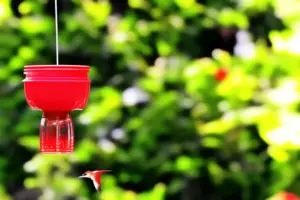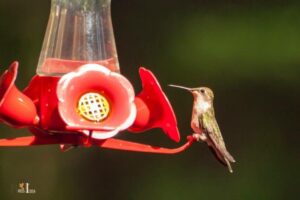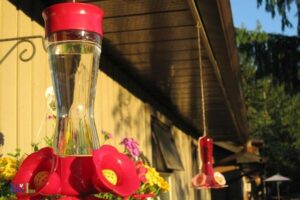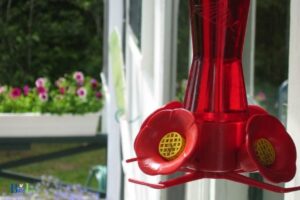Why Does One Hummingbird Guard The Feeder?
One hummingbird may guard the feeder because it is displaying territorial behavior, trying to ensure its own food supply by keeping other hummingbirds away from the feeder.
They may perceive the feeder as a valuable resource and therefore, guard it to prevent other hummingbirds from accessing the nectar.
This behavior ensures that the guarding hummingbird has an uninterrupted supply of food.
By guarding the feeder, the dominant hummingbird can reduce competition for a limited resource, ensuring a consistent food supply for itself.
This, in turn, allows the guarding hummingbird to maintain its energy levels and maximize its chances of success during the breeding season.
6 Reasons for Guarding the Feeder with Explanation:
| Reasons for Guarding the Feeder | Explanation |
|---|---|
| Territorial behavior | Hummingbirds are territorial creatures and will defend their food sources, including feeders, from other hummingbirds. |
| Ensuring enough nectar | Guarding the feeder helps ensure the bird has enough nectar to consume, especially during times of limited natural resources. |
| Attracting a mate | Males may guard a feeder to demonstrate their strength and ability to provide resources to potential mates. |
| Reducing competition | By keeping other hummingbirds away, the bird can reduce competition for available resources in its territory. |
| Predator protection | A hummingbird may guard the feeder to protect itself and its nearby nest from potential predators attracted by the presence of other birds. |
| Minimizing energy expenditure | By establishing a reliable food source and reducing competition, the bird can minimize the energy it expends searching for nectar. |
Key Takeaway
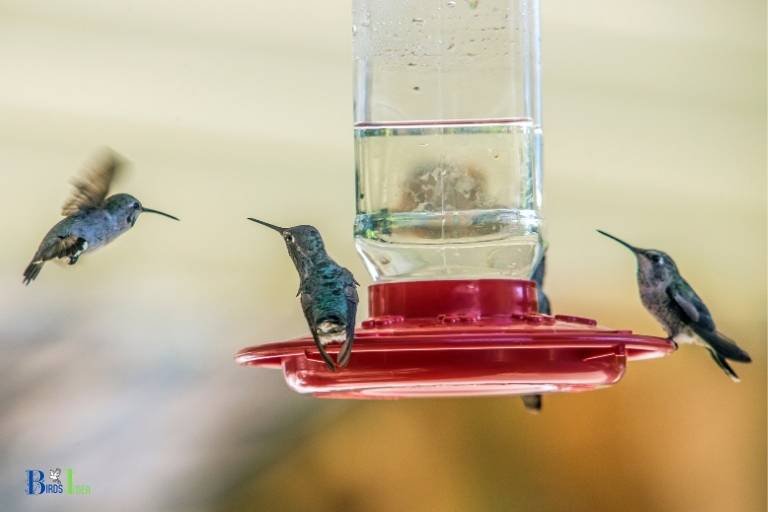
Five Facts About: How Hummingbird Guard The Feeder
What Is the Purpose of a Hummingbird Guarding a Bird Feeder?
The purpose of a hummingbird guarding a bird feeder is to protect its food source and assert dominance over its territory.
Hummingbirds, being territorial creatures, tend to stake claim on a particular feeder, perceiving it as their primary food source. They hover around the feeder to ward off any potential intruders or competing birds to ensure ample nectar supply for themselves.
This behavior serves both individual and species survival, as it allows the guarding bird uninterrupted access to sustenance while maintaining its energy levels.
- Guarding behavior helps to protect the food source
- Asserts dominance over territory
- Ensures ample supply of nectar for the guarding bird
- Contributes to individual and species survival
“Hummingbirds are fiercely territorial and will defend their food sources, mates, and nesting territories with great aggression.”
birdsidea
What Are the Benefits of a Hummingbird Guarding a Bird Feeder?
Hummingbirds are known to be territorial creatures, and one of the benefits of a hummingbird guarding a bird feeder is to protect its food source.
By defending the feeder, the hummingbird can maintain a steady source of nectar for itself and potentially its offspring.
This ensures an uninterrupted supply of energy to meet the high metabolic demands of these tiny, fast-flying birds. Additionally, a hummingbird guarding its territory can help to reduce competition and establish dominance in the area.
- Protects food source
- Maintains steady nectar supply
- Reduces competition
- Establishes dominance in the area
What Behaviors Do Hummingbirds Exhibit When Guarding a Bird Feeder?
Hummingbirds exhibit territorial behaviors when guarding a bird feeder to ensure a constant food source for themselves.
These behaviors include chasing and dive-bombing intruding birds, hovering around the feeder to keep watch, and perching nearby to remain vigilant.
These aggressive actions discourage competition from other hummingbirds, allowing the dominant bird to maintain control over the feeder and its nectar supply.
- Chasing and dive-bombing other birds
- Hovering around the feeder
- Perching nearby
- Aggressive actions towards competing birds
These territorial behaviors are essential for hummingbirds’ survival, as their high metabolism requires a consistent food source, and they need to minimize energy consumption while maximizing resources.
What Is the Difference Between a Hummingbird Guarding a Feeder and Other Birds?
Hummingbirds guarding a feeder exhibit territorial behavior to protect their primary food source, ensuring a continuous supply of energy for their high metabolism.
Unlike other birds, hummingbirds require frequent feeding due to their rapid wing beats and hovering ability, making it crucial for them to defend their food resources.
A single hummingbird might claim a feeder as its territory and drive away competitors to maintain exclusive access, while other bird species may practice communal feeding without such aggression.
Key points:
- Hummingbirds guard feeders to protect their primary food source
- Unique metabolism and energy requirements lead to territorial behavior
- Other bird species may not display such aggressive behavior towards competitors at feeders
How Can You Attract Hummingbirds to Guard a Feeder?
Attracting hummingbirds to guard a feeder can be both interesting and beneficial for these beautiful creatures. Hummingbirds are known for their territorial behavior, in which they will protect a food source, such as a feeder, from other birds.
To encourage a hummingbird to guard a particular feeder, keep the following points in mind:
- Use a brightly colored feeder, preferably red, as hummingbirds are attracted to bright colors and recognize red as a food source.
- Fill the feeder with fresh, homemade nectar made from a mixture of one part sugar to four parts water, ensuring that the nectar is changed regularly to avoid fermentation.
- Place the feeder in a quiet location away from predators and human traffic, yet still visible for them to find it.
- Plant native flowering plants around the feeder to provide additional sources of nectar and cover for resting between feeding sessions.
- Maintain a clean feeder and surrounding area to prevent the spread of disease and deter other pests.
By implementing these steps, you can increase the likelihood of attracting hummingbirds to guard your feeder and enjoy the benefits of their presence in your garden.
What Are the Tips for Maintaining a Hummingbird Feeder with a Guarding Bird?
Maintaining a hummingbird feeder with a guarding bird involves discouraging territorial behavior to ensure that multiple birds can enjoy the feeder.
A guarding bird may claim the feeder as its territory, deterring other hummingbirds from visiting.
Tips for maintaining a feeder with a guarding bird:
- Add more feeders: Place multiple feeders around your yard to spread out the competition and encourage sharing.
- Space out feeders: Keep feeders at least 10-15 feet apart to reduce the chances of one bird claiming all the feeders.
- Use different feeder styles: Offer a variety of feeder types to create a diverse feeding environment and accommodate different bird preferences.
- Provide natural sources: Plant flowers and shrubs to supplement your feeders, making it harder for a single bird to dominate.
- Change feeder location: Regularly move the feeder to prevent birds from getting too attached to a specific spot.
By following these tips, you can create a welcoming and enjoyable environment for all hummingbirds, reducing the chances of having a guarding bird monopolizing your feeder.
Conclusion
In conclusion, hummingbirds guard feeders to protect their food source and territory from other birds and insects.
This behavior is beneficial for the hummingbirds’ survival and ensures that they have access to a reliable source of nectar. Hummingbirds exhibit territorial and aggressive behaviors when guarding a feeder, such as chasing away intruders and displaying dominance.
To attract hummingbirds to guard a feeder, provide a consistent and reliable source of nectar and avoid placing multiple feeders too close together.
It is also important to maintain the feeder and keep it clean to prevent the spread of disease. By understanding why hummingbirds guard feeders and how to attract and maintain them, we can appreciate and enjoy the beauty of these fascinating birds.
TL;DR:
- Hummingbirds guard feeders to protect their food source and territory
- Guarding behavior is beneficial for hummingbirds’ survival
- Hummingbirds exhibit territorial and aggressive behaviors when guarding a feeder
- Provide a consistent and reliable source
According to a study published in the journal Oikos, male hummingbirds are more likely to exhibit aggressive behavior towards other hummingbirds, especially during the breeding season.
birdsidea
FAQ for One Hummingbird Guard The Feeder
Why does a hummingbird guard the feeder?
How do hummingbirds guard the feeder?
How long do hummingbirds guard the feeder?
What happens if a hummingbird does not guard the feeder?
How do I protect my hummingbird feeder?
If you have observed a single hummingbird guard your feeder, it’s because they are fiercely territorial.
To protect your feeder from other birds, follow the below-listed tips:
- Hang the feeder in a shaded area rather than direct sunlight to deter other birds from discovering it.
- Place the feeder in a quiet area, away from noise and activity that might attract other birds.
- Use feeders that have built-in bee guards or ant moats to prevent other insects from accessing the nectar.
- Offer several feeding stations to allow more than one hummingbird to feed at the same time, reducing the likelihood of aggression.
- Move the feeder slightly to a new location every so often, so territorial birds don’t become too accustomed to the feeder’s location.
- As a last resort, offer multiple feeders to members of your local hummingbirds’ community.
By following these tips, you can protect your hummingbird feeder and allow these unique birds to visit and feed in peace.
Why does hummingbird hang upside down from feeder?
When a hummingbird hangs upside down from a feeder, it’s usually to get to the nectar that is stuck at the bottom of the feeder.
These birds are known for their flexibility and agility, and they are capable of performing a variety of acrobatic maneuvers to reach their desired food source.
Hanging upside down also allows them to clean out any remaining nectar that may have settled at the bottom of the feeder.
Another reason why a hummingbird may hang upside down is to cool off on a hot day. By positioning themselves in this way, they can expose their belly feathers to the air and regulate their body temperature.
Overall, hummingbirds are fascinating creatures that exhibit a variety of unique behaviors.
What is the personality of a hummingbird?
Hummingbirds are known to have interesting personalities, which vary according to their species.
Some of the common characteristics of a hummingbird’s personality are:
- Aggressiveness: Hummingbirds can be territorial and will fiercely defend their feeding areas from other birds and animals.
- Playfulness: Hummingbirds are known to be curious and enjoy exploring their surroundings, often engaging in playful behavior.
- High energy: These birds have a rapid metabolism and must eat almost constantly to maintain their energy levels. They are always on the move and seem to have boundless energy.
- Fearlessness: Despite their small size, hummingbirds are fearless creatures and will fearlessly confront much larger animals and birds.
Overall, the personality of a hummingbird can be described as dynamic, energetic, and adaptable. They are fascinating creatures to observe and have a unique charm that captivates bird enthusiasts around the world.
Regarding the previous heading, “why does one hummingbird guard the feeder,” the aggressiveness and territorial behavior mentioned above could explain why that particular hummingbird is guarding the feeder.
Why does a hummingbird hum?
Hummingbirds are known for their unique ability to hover in mid-air while flapping their wings rapidly. But why do they hum during the process?
Here are some reasons:
- Humming is the byproduct of their rapid wing beats, which occur at a rate of up to 80 beats per second.
- The sound they produce may act as a warning system to other hummingbirds that the territory is already taken.
- Humming could also be a means of communication, as male hummingbirds use vocalizations and visual displays to attract mates.
- Additionally, some studies suggest humming helps regulate their breathing as they have very high metabolic rates and need to constantly feed.
So next time you hear the hum of a hummingbird, know that it’s a fascinating aspect of their biology and behavior.
Why is a hummingbird flying around me?
If you have ever been outside and noticed a hummingbird flying around you, it can be quite an exhilarating experience. These tiny, colorful birds are known for their aerial acrobatics and their ability to hover in one spot.
Here are some reasons why a hummingbird might be flying around you:
- Curiosity: hummingbirds are intelligent and curious creatures and may investigate new things in their environment.
- Feeding: if you are wearing brightly colored clothing or have recently applied perfume or lotion, a hummingbird might mistake you for a flower and hover close to you.
- Nesting: during breeding season, a female hummingbird may be looking for a suitable place to build a nest and could be checking out potential sites in your vicinity.
While having a hummingbird flying around you can be entertaining, it’s essential to not disturb or harm these precious creatures, as they are integral to our ecosystem.
How many calories does a hummingbird burn in a day?
Hummingbirds are known for their high metabolism and the ability to flap their wings rapidly. As a result, they burn an enormous amount of energy in a day.
On average, a hummingbird can burn anywhere from 50 to 200% of their body weight in a day. For example, a 3-gram hummingbird can burn up to 6 grams of fat in a single day.
The amount of calories a hummingbird burns is dependent on several factors such as its weight, activity level, and environmental conditions.
To compensate for their high energy expenditure, hummingbirds consume nectar from flowers, insects, and sugar-water feeders. These tiny birds have adapted to an active and energy-consuming lifestyle that allows them to survive in their natural habitats.

